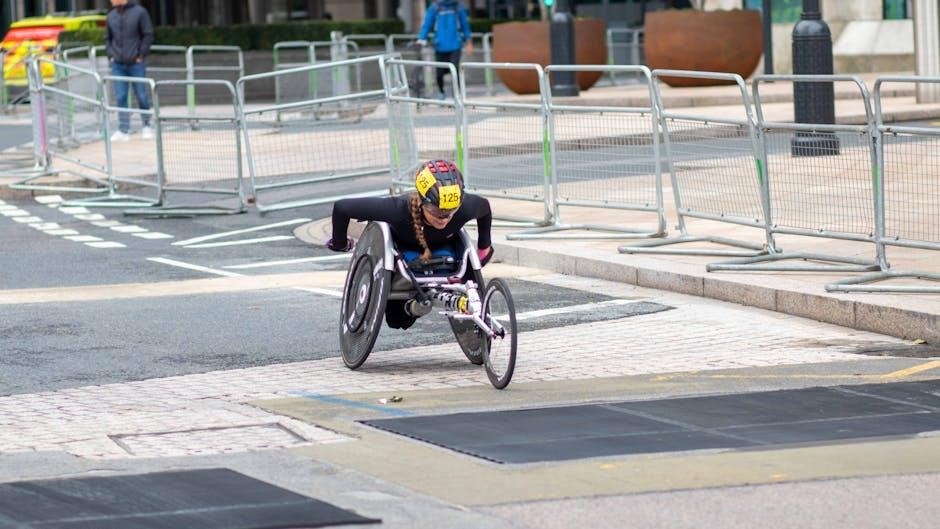1․1 Definition and Explanation
Internalized homophobia is a deeply held belief that being LGBTQ+ is inherently wrong or unacceptable․ It arises from societal norms, family values, and media representation that perpetuate negative stereotypes․ This phenomenon manifests as self-shame, low self-esteem, and emotional distress, significantly impacting mental health․ Individuals may experience feelings of guilt, self-loathing, and anxiety, which can strain relationships and hinder personal growth․ Recognizing and understanding internalized homophobia is the first step toward healing and embracing one’s authentic identity․
1․2 The Impact on Mental Health
Internalized homophobia significantly impacts mental health, often leading to anxiety, depression, and low self-esteem․ It can result in self-loathing, emotional distress, and even suicidal thoughts․ The internal conflict between one’s identity and societal expectations may cause feelings of isolation and self-doubt․ This psychological burden can strain relationships and hinder personal growth․ Studies have shown links between internalized homophobia and substance abuse, as individuals may cope with their pain through harmful behaviors․ Addressing these mental health challenges is essential for healing and achieving emotional well-being․
1․3 Why It’s Important to Address
Addressing internalized homophobia is crucial for fostering self-acceptance and emotional well-being․ It empowers individuals to break free from societal conditioning, embracing their authentic selves with confidence․ By confronting these deeply ingrained beliefs, individuals can heal from self-shame and build resilience against discrimination․ This process not only improves mental health but also strengthens relationships and overall quality of life․ Moreover, addressing internalized homophobia promotes a more inclusive and supportive community, empowering LGBTQ+ individuals to thrive and advocate for their rights․

Understanding the Causes of Internalized Homophobia
Internalized homophobia arises from societal norms, family upbringing, media stereotypes, and religious teachings that perpetuate negative views of LGBTQ+ identities, leading to self-shame and emotional conflict․
2․1 Societal Influences and Norms
Societal influences play a significant role in shaping internalized homophobia․ Norms often perpetuate heteronormativity, marginalizing LGBTQ+ identities․ Media stereotypes, legal discrimination, and public opinion contribute to feelings of shame and self-doubt․ Studies by Plummer (2001) and McCormick Cook (2018) highlight how societal rejection fosters internalized homophobia, leading to emotional distress․ Addressing these influences is crucial for personal liberation and embracing authenticity․
2․2 Family and Upbringing
2․2 Family and Upcoming
Family and upbringing significantly contribute to internalized homophobia․ Growing up in environments with negative comments about LGBTQ+ identities can instill self-shame․ Studies by McCormick Cook (2018) and Jackson (2022) show that rejection sensitivity and emotional distress often stem from familial disapproval․ Parental expectations rooted in heteronormative values can lead to self-loathing and low self-esteem․ These early experiences shape self-perception and are deeply tied to societal norms, making them a primary source of internalized homophobia․
2․3 Media Representation and Stereotypes
Media representation and stereotypes play a significant role in shaping internalized homophobia․ Limited and negative portrayals of LGBTQ+ individuals in media often perpetuate harmful stereotypes, reinforcing self-doubt and shame․ Studies highlight how underrepresentation and stereotyping in media contribute to feelings of inadequacy and low self-esteem․ Exposure to homophobic language and narratives in media can deepen internalized homophobia, especially when positive representations are scarce․ Addressing these biases is essential for fostering self-acceptance and challenging harmful societal norms․
2․4 Religious and Cultural Teachings
Religious and cultural teachings often perpetuate internalized homophobia by promoting beliefs that same-sex attraction is immoral or unnatural; Many individuals grow up in environments where these teachings are deeply ingrained, leading to feelings of shame and self-rejection․ Cultural norms that emphasize heterosexuality as the only acceptable orientation further exacerbate this internal conflict․ These influences can make it difficult for individuals to reconcile their faith or heritage with their sexual identity, contributing to emotional distress and self-loathing․

Recognizing the Signs of Internalized Homophobia
Recognizing internalized homophobia involves identifying self-shame, emotional distress, and negative beliefs about one’s identity․ It often manifests as self-doubt, avoidance of LGBTQ+ communities, or self-sabotaging behaviors․
3․1 Emotional Signs: Shame, Guilt, and Self-Loathing
Emotional signs of internalized homophobia often manifest as deep-seated shame, guilt, and self-loathing․ These feelings stem from societal norms and heterosexism, leading individuals to view their identity as flawed or unacceptable․ Shame may arise from fearing rejection or judgment, while guilt often follows behaviors or attractions that conflict with internalized beliefs․ Self-loathing can result in self-blame and emotional pain, further exacerbating mental health challenges․ Recognizing these emotions is crucial for understanding the internal conflict caused by internalized homophobia․
3․2 Behavioral Signs: Self-Sabotage and Avoidance
Behavioral signs of internalized homophobia may include self-sabotage and avoidance․ Individuals might avoid romantic or social situations due to fear of rejection or shame․ Self-sabotage can manifest as self-destructive behaviors, such as substance use or harmful relationships, to cope with internalized shame․ Avoidance behaviors, like hiding one’s true identity or distancing from LGBTQ+ communities, can further isolate individuals and reinforce feelings of inadequacy․ These actions often stem from a deep-seated belief that being LGBTQ+ is unacceptable, perpetuating a cycle of self-doubt and emotional pain․
3․3 Relational Signs: Difficulty in Intimate Relationships
Internalized homophobia often manifests in relational challenges, making it difficult to form and maintain intimate connections․ Fear of rejection, shame, and self-doubt can lead to emotional unavailability or an inability to trust partners․ Some individuals may struggle with intimacy due to feelings of unworthiness or a deep-seated belief that they are unlovable․ This can result in unstable or unfulfilling relationships, as the internalized shame creates barriers to genuine emotional connection and mutual understanding․

The Process of Overcoming Internalized Homophobia
Overcoming internalized homophobia is a journey of self-discovery, requiring acknowledgment of harmful beliefs and gradual redefinition of self-identity through self-compassion, support, and mindful personal growth․
4․1 Acknowledging and Accepting Your Feelings
Acknowledging internalized homophobia begins with recognizing and accepting your emotions without judgment․ This step involves admitting feelings of shame, guilt, or self-doubt rooted in societal or familial norms; Acceptance doesn’t mean agreeing with these beliefs but rather confronting them as part of your experience․ By validating your emotions, you create space for self-compassion and understanding, which are essential for healing․ This process lays the foundation for challenging harmful beliefs and embracing your authentic self, marking the first step toward liberation from internalized homophobia․
4․2 Building Self-Awareness and Self-Compassion
Building self-awareness involves recognizing and understanding the deeply rooted beliefs and emotions tied to internalized homophobia․ This process requires introspection and honesty about how societal, familial, or cultural influences have shaped your self-perception․ Practicing self-compassion means treating yourself with kindness, especially when confronting painful or shameful feelings․ By acknowledging your humanity and the validity of your experiences, you can begin to dismantle self-criticism and foster a more nurturing relationship with yourself․ This step is crucial for healing and reclaiming your authentic identity․
4․3 Challenging Negative Beliefs and Thought Patterns
Challenging negative beliefs involves identifying and questioning harmful thought patterns rooted in internalized homophobia․ Techniques like cognitive restructuring can help reframe self-critical thoughts into more balanced and affirming ones; This process requires confronting societal and cultural messages that have perpetuated shame and self-doubt․ By actively disputing these beliefs, individuals can reduce self-criticism and cultivate a more compassionate and accepting mindset․ This step is vital for breaking free from the cycle of negative self-perception and fostering emotional healing and growth․
4․4 Redefining Your Identity and Sense of Self
Redefining your identity involves moving beyond internalized homophobia to embrace a positive and authentic sense of self․ This process requires self-compassion and acceptance, allowing individuals to align their beliefs with their true selves․ It involves letting go of harmful labels and embracing queer identity as a natural and valid part of human diversity․ By redefining self-perception, individuals can break free from shame and build confidence, fostering a more authentic and fulfilling life․
4․5 Building a Supportive Network and Community
Building a supportive network and community is vital for overcoming internalized homophobia․ Surrounding yourself with understanding peers fosters acceptance and reduces feelings of isolation․ Engaging in LGBTQ+ affirming spaces, whether online or in-person, provides validation and shared experiences․ These communities offer resources, mentorship, and a sense of belonging, which are crucial for healing․ By participating in such networks, individuals can redefine their identities, gain confidence, and embrace their authentic selves, leading to personal growth and empowerment․
4․6 Seeking Professional Help and Therapy
Seeking professional help and therapy is a critical step in overcoming internalized homophobia․ Trained therapists can provide a safe, non-judgmental space to explore and address deep-seated beliefs and emotions․ Cognitive-behavioral therapy (CBT) and psychodynamic therapy are effective approaches to challenge negative thought patterns and reframe self-perceptions․ Therapy also helps individuals process trauma, develop self-compassion, and build resilience․ Working with a therapist who specializes in LGBTQ+ issues ensures tailored support, fostering a journey toward self-acceptance and empowerment․
4․7 Practicing Mindfulness and Self-Care
Practicing mindfulness and self-care is essential for healing from internalized homophobia․ Mindfulness helps individuals stay present, reducing self-criticism and fostering self-compassion․ Techniques like meditation, deep breathing, and journaling can calm the mind and promote emotional balance․ Self-care practices, such as engaging in hobbies, exercising, or spending time in nature, nurture physical and mental well-being․ By prioritizing self-care, individuals can reframe negative beliefs, build resilience, and cultivate a positive, authentic sense of self․
4․8 Embracing and Celebrating Your Authentic Self
Embracing and celebrating your authentic self is a powerful step in overcoming internalized homophobia․ It involves letting go of shame and fully accepting your identity with compassion and pride․ By aligning your actions and beliefs with your true self, you reclaim your dignity and foster self-love․ Surrounding yourself with supportive communities and role models can amplify this process․ Celebrating your authenticity not only honors your journey but also empowers you to live a more fulfilling, resilient, and genuine life, free from the weight of internalized homophobia․

Strategies for Healing and Growth
Strategies for healing involve self-reflection, education, and activism․ Educating oneself about LGBTQ+ history fosters pride and challenges harmful stereotypes․ Engaging in activism promotes societal change and personal empowerment․ Finding role models and mentors provides inspiration and guidance․ Journaling and expressive writing help process emotions and redefine identity, aiding in overcoming internalized homophobia․
5․1 Educating Yourself About LGBTQ+ History and Rights
Educating yourself about LGBTQ+ history and rights is a powerful step in overcoming internalized homophobia․ Learning about the achievements, struggles, and contributions of LGBTQ+ individuals fosters pride and challenges harmful stereotypes․ Understanding the history of the LGBTQ+ rights movement highlights resilience and progress, empowering individuals to reclaim their identity․ This knowledge also provides context for societal homophobia, helping to address internalized shame and build self-acceptance․ By embracing this education, you can better advocate for yourself and others, promoting a more inclusive and compassionate society․
5․2 Engaging in Activism and Advocacy
Engaging in activism and advocacy can be a transformative way to combat internalized homophobia․ By standing up for LGBTQ+ rights, individuals challenge societal norms and stereotypes that perpetuate shame․ Activism fosters resilience, solidarity, and a sense of purpose, helping to replace self-doubt with empowerment․ Whether through protests, campaigns, or community work, advocating for equality allows individuals to reclaim their identity and reject harmful narratives․ This process not only promotes personal growth but also contributes to broader societal change, creating a more inclusive world for all․
5․3 Finding Role Models and Mentors
Finding role models and mentors is a powerful step in overcoming internalized homophobia․ They provide inspiration, guidance, and validation, helping individuals embrace their authentic selves․ Role models, whether public figures or personal acquaintances, demonstrate resilience and self-acceptance, challenging harmful stereotypes․ Mentors offer support and wisdom, aiding in navigating identity struggles and fostering self-confidence․ By learning from others’ journeys, individuals gain tools to address internalized shame and develop a stronger sense of self, ultimately fostering personal growth and empowerment․
5․4 Journaling and Expressive Writing
Journaling and expressive writing are therapeutic tools for processing emotions and challenging internalized homophobia․ Writing about personal experiences, feelings, and beliefs can help individuals identify and confront harmful self-perceptions․ It provides a safe space to explore identity, validate emotions, and reframe negative thoughts․ Over time, journaling can foster self-awareness, self-compassion, and acceptance, empowering individuals to reclaim their authenticity․ Regular practice encourages introspection, healing, and personal growth, serving as a meaningful step toward overcoming shame and embracing one’s true self․

The Role of Therapy in Overcoming Internalized Homophobia
Therapy helps address internalized homophobia by exploring harmful beliefs, developing coping strategies, and fostering self-acceptance․ It provides a safe space for healing and growth․
6․1 Cognitive-Behavioral Therapy (CBT)
Cognitive-Behavioral Therapy (CBT) is a powerful approach to addressing internalized homophobia by identifying and challenging negative thought patterns․ It helps individuals recognize how societal norms and personal beliefs contribute to self-shame․ Through cognitive restructuring, individuals learn to replace harmful beliefs with affirming ones․ Behavioral exercises encourage positive actions that align with self-acceptance․ CBT provides practical tools to manage emotional distress and fosters a supportive environment for healing and growth, empowering individuals to embrace their authentic selves․
6․2 Psychodynamic Therapy
Psychodynamic therapy explores the unconscious emotions and past experiences that contribute to internalized homophobia․ It helps individuals understand how childhood influences, societal norms, and internalized beliefs shape their self-perception․ By examining these roots, individuals can gain insight into how past experiences fuel self-shame and negative behaviors․ The therapeutic relationship becomes a safe space to process these feelings, fostering self-awareness and emotional healing․ This approach aims to release the grip of internalized homophobia by addressing its deeper, often unconscious origins․
6․3 Group Therapy and Support Groups
Group therapy and support groups provide a safe space for individuals to share experiences and connect with others facing similar challenges․ These settings normalize feelings of internalized homophobia and reduce isolation․ Participants often find comfort in realizing they are not alone in their struggles․ Group activities, such as storytelling and collaborative exercises, foster mutual understanding and validation․ This collective support helps individuals reframe their identity and build resilience․ Being part of a community can empower individuals to heal and embrace their authentic selves in a supportive and non-judgmental environment․
6․4 Trauma-Informed Care
Trauma-informed care is an approach that acknowledges the profound impact of trauma on individuals, particularly those grappling with internalized homophobia․ It emphasizes creating a safe, non-judgmental environment where clients feel empowered to process their experiences․ This method recognizes how societal rejection and internalized shame can manifest as trauma, requiring compassionate and sensitive intervention․ By focusing on understanding rather than “fixing,” trauma-informed care helps individuals rebuild trust and explore their identity without fear of judgment, fostering resilience and self-acceptance;

Building a Supportive Community
Creating a supportive community involves finding LGBTQ+ affirming spaces, engaging in shared experiences, and fostering understanding․ It helps individuals feel safe, valued, and connected, reducing isolation․
7․1 Finding LGBTQ+ Affirming Spaces
Finding LGBTQ+ affirming spaces is crucial for healing and growth․ These spaces, such as community centers, support groups, and cultural events, provide safety and acceptance․ They reduce feelings of isolation and alienation, allowing individuals to connect with others who share similar experiences․ Online directories and local organizations can help identify these spaces․ Engaging in such environments fosters a sense of belonging and validation, which is essential for overcoming internalized homophobia and embracing one’s identity․
7․2 Participating in Online Forums and Communities
Participating in online forums and communities provides a safe space for connection and support․ These platforms allow individuals to share experiences, receive validation, and access resources for overcoming internalized homophobia․ Online communities often offer anonymity, making it easier for those in less accepting environments to engage openly․ They also foster a sense of belonging and reduce feelings of isolation, which are critical for healing and growth․ Engaging with others who understand similar struggles can empower individuals to embrace their identities and work toward self-acceptance․
7․3 Attending Workshops and Events
Attending workshops and events focused on overcoming internalized homophobia can be a transformative experience․ These gatherings provide educational resources, emotional support, and opportunities to connect with others who share similar journeys․ Workshops often include guided exercises, expert insights, and peer discussions, helping individualschallenge harmful beliefs and build confidence․ Events also foster a sense of community, reducing feelings of isolation and shame․ By engaging in these spaces, individuals can gain tools for healing, empower themselves, and cultivate a stronger sense of self-acceptance and authenticity․
7․4 Creating Personal Boundaries
Creating personal boundaries is essential for healing from internalized homophobia․ Boundaries help protect against harmful influences and negative societal expectations, allowing individuals to prioritize their well-being․ Learning to say “no” to toxic environments and relationships fosters self-respect and authenticity․ By setting clear limits, individuals can distance themselves from judgmental attitudes and embrace their true selves․ Boundaries also promote emotional safety, enabling individuals to navigate spaces confidently and surround themselves with supportive, affirming people․

The Importance of Self-Compassion
Self-compassion is vital for healing from internalized homophobia, as it fosters kindness and acceptance toward oneself․ It helps counteract societal and internalized negativity, promoting emotional resilience․
8․1 Understanding the Concept of Self-Compassion
Self-compassion is the practice of treating oneself with kindness, understanding, and patience, especially during difficult times․ It involves acknowledging humanity and imperfections without judgment․ For individuals grappling with internalized homophobia, self-compassion is a powerful tool to counteract societal and internalized negativity․ By embracing self-compassion, one can develop resilience, reduce self-criticism, and foster a nurturing relationship with themselves․ This concept encourages acceptance of one’s authentic self, helping to heal from shame and build a foundation for emotional well-being and personal growth․
8․2 Practicing Self-Forgiveness
Self-forgiveness is a vital step in healing from internalized homophobia․ It involves letting go of guilt and self-criticism tied to past choices or feelings․ Recognizing that these emotions often stem from societal pressures or misinformation can help individuals release shame․ By acknowledging humanity and the complexity of their journey, they can cultivate compassion for their past selves․ Self-forgiveness is not about erasing mistakes but embracing them as part of growth, fostering peace and self-acceptance․
8․3 Developing a Growth Mindset
Developing a growth mindset is essential for overcoming internalized homophobia․ It involves embracing challenges as opportunities for growth rather than sources of shame․ By understanding that beliefs and behaviors can evolve, individuals can move beyond rigid, harmful narratives; A growth mindset fosters resilience, allowing people to reframe past struggles as stepping stones toward self-acceptance․ Cultivating self-compassion and patience with oneself during this journey is key․ This mindset encourages aligning self-perception with one’s authentic identity, celebrating progress, and embracing continuous personal evolution․
Overcoming internalized homophobia is a transformative journey of healing, self-discovery, and embracing authenticity․ It requires courage, resilience, and support, but leads to profound liberation and empowerment․
9․1 The Journey Toward Healing
The journey toward healing from internalized homophobia is a deeply personal and transformative process․ It begins with acknowledging the pain and shame imposed by societal norms and self-imposed beliefs․ Through self-compassion, mindfulness, and support, individuals can gradually dismantle harmful thought patterns and embrace their authentic selves․ This path requires patience, courage, and often the guidance of supportive communities or professionals․ Healing is not linear, but each step forward fosters resilience and empowerment, ultimately leading to a life of freedom and self-acceptance․
9․2 The Power of Resilience
Resilience is a cornerstone in overcoming internalized homophobia, enabling individuals to transform pain into strength․ It involves adapting to adversity, challenging harmful beliefs, and embracing one’s true identity․ Through resilience, people develop coping strategies, rebuild self-esteem, and foster emotional well-being․ This journey often involves support from communities, therapy, and self-compassion, helping individuals rise above societal expectations and internalized shame․ Resilience empowers LGBTQ+ individuals to reclaim their narratives, celebrate their authenticity, and live fulfilling lives free from self-doubt․
9․3 A Message of Hope and Empowerment
Overcoming internalized homophobia is a journey marked by hope and empowerment․ Healing is possible through self-compassion, support, and embracing authenticity․ Every step toward self-acceptance is a victory, fostering resilience and confidence․ Remember, you are not alone—resources, communities, and therapies exist to guide you․ Celebrate your identity, knowing your worth and the beauty of your true self․ Empowerment lies in reclaiming your narrative and living unapologetically, surrounded by love and acceptance․
Resources for Further Support
Explore recommended books, join online forums, consult professional therapists, and access hotlines for guidance․ These resources provide tools and communities to aid your journey․
10․1 Recommended Books and Articles
Explore books like Overcoming Heterosexism and Homophobia by Sebesta and Internalized Homophobia and the Negative Therapeutic Reaction by McCormick Cook․ Articles by Jackson and Work offer insights into stigma’s impact on mental health․ These resources provide a deeper understanding of internalized homophobia, offering strategies for healing and personal growth․ Academic studies and personal memoirs alike can empower individuals with knowledge and tools to navigate their journey toward self-acceptance and emotional liberation․
10․2 Online Communities and Forums
Joining online communities and forums can provide vital support and connection․ Platforms like Reddit’s r/lgbt, online support groups, and specialized forums offer safe spaces to share experiences and receive guidance․ These communities often feature discussions on overcoming internalized homophobia, with members sharing personal stories and strategies for healing․ Many forums also provide access to resources, such as articles, webinars, and recommended reading materials․ Engaging with these online spaces can foster a sense of belonging and empowerment, helping individuals navigate their journey toward self-acceptance and emotional liberation․
10․3 Professional Therapists and Counselors
Working with professional therapists or counselors specializing in LGBTQ+ issues can be transformative․ These experts provide a safe, non-judgmental space to explore internalized homophobia and develop coping strategies․ Therapies like CBT or psychodynamic therapy can help reframe negative beliefs and foster self-acceptance․ Many therapists are trained in affirming care, offering tailored support to address unique challenges․ Seeking professional help is a courageous step toward healing and reclaiming one’s identity․ Confidentiality and empathy are cornerstones of this process, enabling individuals to confront and overcome deep-seated shame․
10․4 Hotlines and Emergency Support Services
Hotlines and emergency support services provide immediate assistance to individuals struggling with internalized homophobia․ These services offer emotional support, crisis intervention, and referrals to local resources․ Many hotlines operate 24/7, ensuring help is available whenever needed․ Confidentiality is a priority, making these services a safe space for those seeking urgent care․ Reaching out to these services can be a lifeline, reminding individuals they are not alone in their journey toward healing and self-acceptance․